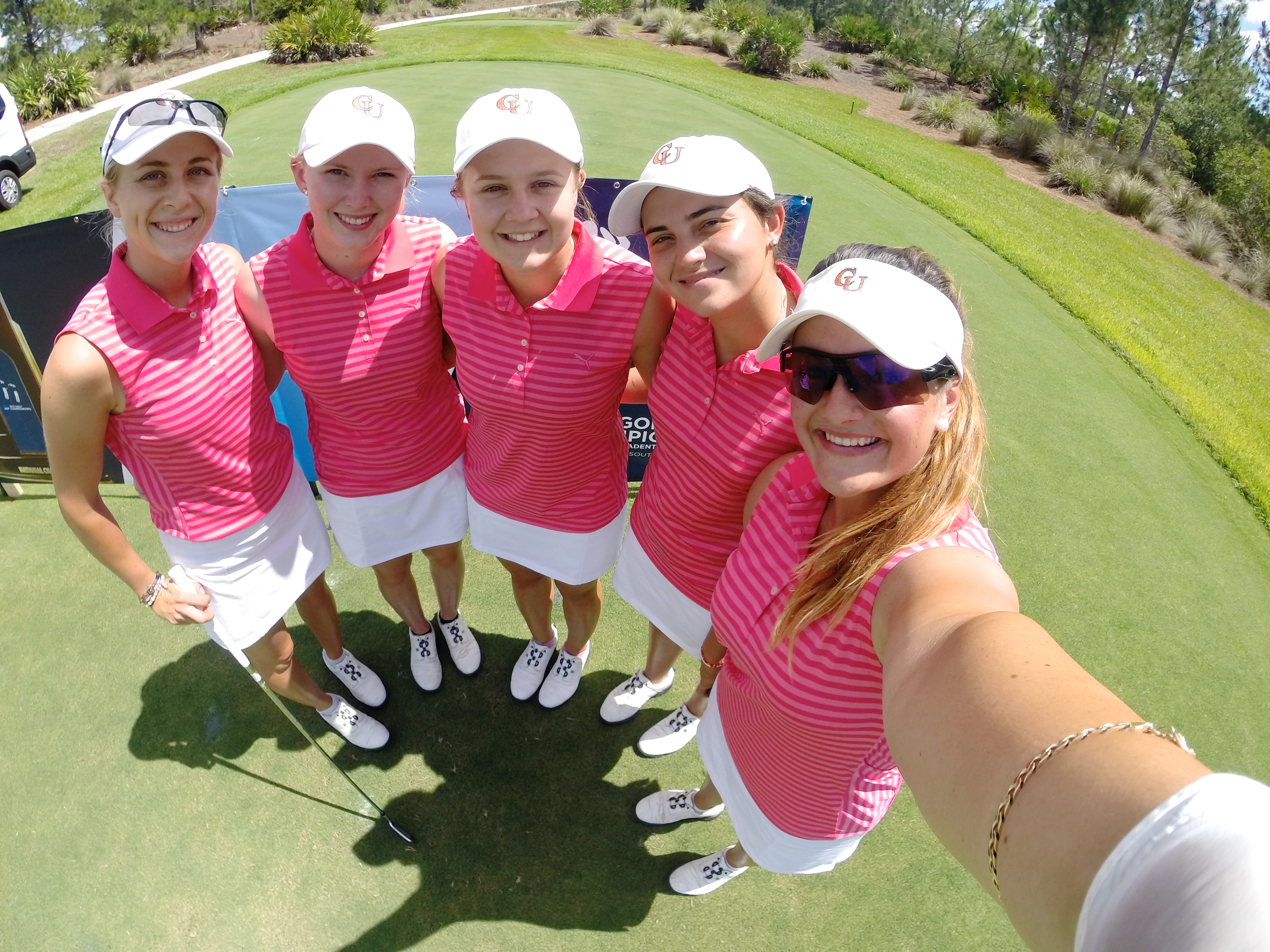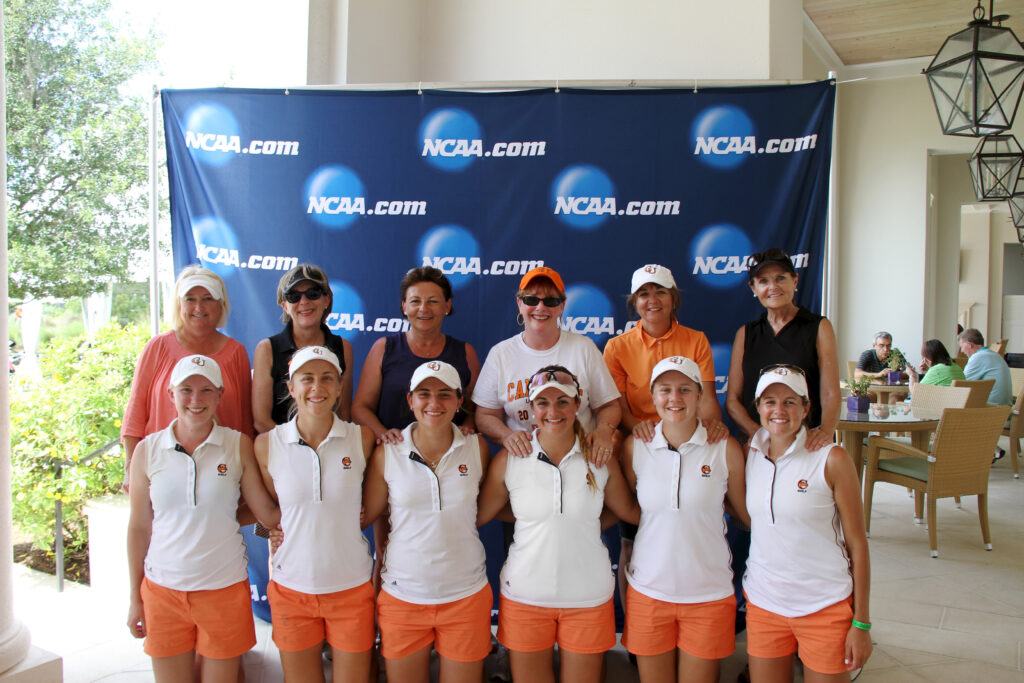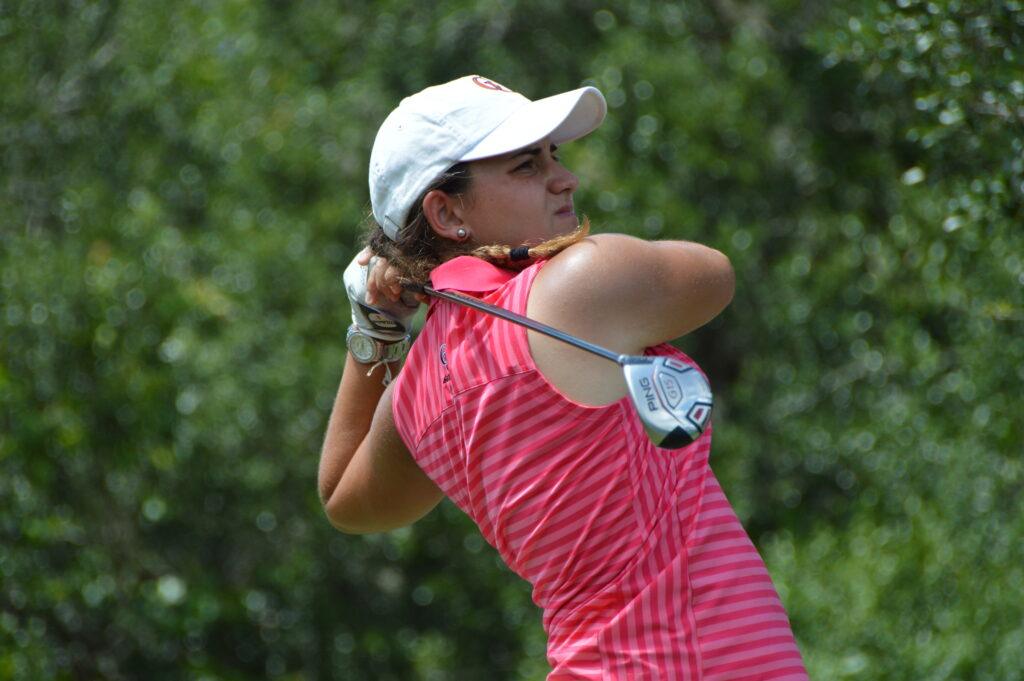It’s a much-needed moment of levity before the biggest golf tournament of their lives.
Senior Lisbeth Brooks is approached by a reporter from the nearby Sarasota Herald-Tribune, who’s intrigued by Campbell’s mascot and the fuzzy Camel-head driver cover in Brooks’ bag.
“He’s Gaylord the Camel,” she tells the writer. “But most people think he’s a horse.”
He asks Brooks about the team’s chant before they tee off — a chant that ends with a “camel sound.” “Rawwrrgh!” she demonstrates as her teammates laugh behind her.
“Or,” she adds as the laughter dies down, “we could just spit.”
There aren’t many national title-worthy women’s golf teams like Campbell University’s, and this has nothing to do with the girls’ ability to crack jokes and laugh when the pressure’s on and nothing to do with their unique mascot with the funny name. Scroll down the list of the 24 schools in Bradenton, Florida, competing for the coveted NCAA Division I Championship, and you get the sense that Campbell doesn’t belong.
USC. Duke. Arizona. LSU. Alabama. Texas A&M. Tennessee. UCLA. The opposition has an average enrollment of 33,300 students, more than five times that of Campbell’s 6,400.

But Brooks, senior Brooke Bellomy, junior Tahnia Ravnjak and sophomores Louise Latorre and Nadine White do belong. Four of the five are here for the second year in a row, making Campbell one of only 15 teams in the field making a return appearance in 2015.
And while the camel is still getting its fair share of attention, fewer people are asking where Buies Creek is located. Fewer people are mistaking their orange for Tennessee. And nobody is calling Campbell’s appearance a “fluke.”
“Last year was special, and I’m not going to downplay that,” says Brooks. “But getting here two years in a row? It shows we deserve to be here.”
In 2014, Campbell (led by then-senior Kaylin Yost) entered regionals as the Big South champion and shot a school-record for a 54-hole tournament at the NCAA Regionals in Tallahassee, Florida, to advance to the Championships in Tulsa, Oklahoma. Their road in 2015 was more difficult — the Camels finished second in the Big South Tournament behind Coastal Carolina and relied on an at-large bid to get to Regionals in Raleigh. There, the girls entered the final round on the outside looking in at the Top 6 spots needed to move on.
Led by the two seniors, Campbell finished the final three holes with a flurry of pin-point birdie and par putts to claim the sixth and final spot to advance to the championships.
“We seemed to have approached a lot of tournaments this year as if we didn’t want to make mistakes and we wanted to be careful,” says their head coach, John Crooks. “We knew we were good, but we didn’t want to do stupid things. At the regionals, I told them, ‘Forget doing stupid things. You’re real good. Go do what you do.’”
Bellomy, on the eve of her final tournament as a Camel, calls Raleigh her favorite Campbell moment.
“I just thought, ‘Wow,’” she says. “Seeing everybody’s faces and being able to pour water on Coach; and to see him smiling and his wife crying because she was so happy for us — that was a good moment.”
WELCOME TO THE JUNGLE

North Carolinians think they know heat and humidity.
Not counting trips to Disney World, very few have ever spent four consecutive days outdoors in Central Florida in late May, walking the equivalent of six miles each day while breathing soup-thick steamy air in 95-degree heat.
The Concession — a grueling course without the heat — offers little by way of shade for both players and spectators. Those areas that do offer respite with towering pines and palm trees are surrounded by palmettos, other native vegetation and wetlands, hiding an array of snakes and more than a few alligators.
For teams like the University of Washington and Northwestern, Bradenton (about 30 minutes south of Tampa) may as well be Mars. Even Campbell’s squad — represented by two Australians, one French and two Americans from West Virginia and Wisconsin — isn’t accustomed to these elements. Only White, from the northern (and thus, hotter) part of Australia, and assistant coach Ryan Ashburn (an alum and standout golfer from Stetson University near Orlando) feel at home this close to the Equator.
Day 1 of their four-day stint is 18 holes of practice-round golf — by far the most important hours leading up to any tournament, says Ashburn.
“You gather a lot of information about a golf course on a day like this,” she says, cool towel draped over her neck. “Today gets their mindset going. We’ve been working on a lot of things the past few weeks, and today is the day they get to try out what they’ve learned. They get to test the greens, see which way the ball rolls on what holes. The more you know about a course, the more confident you are.”
It gets them used to the climate, too, she says.
“It gets hot in North Carolina, but this … this is different,” she adds.
They spend 10 minutes on one green trying to master the six-foot drop that welcomes anyone who hits just right of the pin. At 4 p.m., with the heat at its most brutal, the five girls chip multiple times before they’re comfortable enough to move on.
Not that it’s all work and no play.
Ravnjak has fun with her GoPro camera, stopping for “selfies” in front of several blue-circled NCAA signs throughout the course, and getting her teammates to jump on the spot where the logo is painted on the 12th fairway. Brooks has been known to keep a water pistol in her bag (more welcome on a day like this), and it becomes evident while watching other teams — some of whom barely speak to each other while focusing solely on the next shot — that team chemistry isn’t just a strength for Campbell. It’s vital.
“I don’t even consider us a team. I consider us best friends,” says Brooks. “You hear all these stories about how other teams, especially girl teams, have a lot of personality clashes. But Coach recruits the person before the player, so all the people that come in are generally good-hearted people.”
When you’re around teammates this much, personality helps. During their 2014-15 campaign, the team traveled to South Carolina and Colorado in September; Daytona Beach and back to South Carolina in November; Orlando in February; South Carolina for a third time, Tucson, Arizona and Coral Gables in March and a final trip to South Carolina for the Big South Championship in April before the Regional in Raleigh in early May.
Downtime, the girls say, is usually spent in their hotel rooms, watching mindless TV shows like “The Kardashians” or, ahem, “Dance Moms.” Thursday evenings are dominated by “Grey’s Anatomy” and “Scandal.”
“It sounds boring, but it’s not,” says White. “After a round, we just want to relax. There isn’t a lot of time to do anything else.”
What they don’t do is fight. Ever, says Bellomy … which is an accomplishment in itself considering the long van trips, long flights and multiple nights in shared hotel rooms.
“We really care for each other, and that’s what you need,” she says. “When we go to tournaments, we’re gone for four or five days. We’re spending so much extra time together … who else would you want to spend time with?”
ONE BIG FAMILY

John Crooks won a USGA junior national championship and an NCAA championship as a player at the University of Houston. As a coach, he’s led Campbell’s men’s and women’s golf teams to 12 conference titles and 18 NCAA post-season berths. This year marked the women’s third trip to the NCAA Championships under Crooks, who ranks fourth all-time and second among active Division I head coaches with 76 tournament victories.
Yet when the 2006 National Golf Coaches Association Hall of Fame inductee is asked during his girls’ practice round in Bradenton what he was looking for, his answer has nothing to do with golf.
“The main thing is that some of their parents are here,” he says, sitting in his cart and mixing orange Powerade with ice-cold water. “Some of them haven’t seen their parents in four or five months. That’s taking priority right now.
“As far as golf goes … they’ll be OK.”
The two Aussies are joined by their parents for the week, and Latorre’s parents and older sister will be coming in from France the following morning. For Vicki Ravnjak, Tahnia’s mother, this marks the first time she’s ever seen her daughter play in the United States. What amounted to a 30-hour trip because of flight delays and extended layovers can’t break the excitement she has to see Tahnia play against the world’s best collegiate golfers.
“Tahnia’s goal is to play on the LPGA Tour, and being here gives her the best opportunity,” she says. “Was it tough letting her go? Of course, but I want her to follow her dreams. I don’t want her looking back down the line and saying, ‘What if?’”
It helps, she says, that Tahnia is part of a “big, happy family” at Campbell. She views Coach Crooks as a father figure to the girls, a sentiment echoed by the other Australian parents in town, Nadine’s parents Bryan and Joanne.
“It’s not difficult to send them away when they’re living their dreams,” says Joanne.
“We have nothing like this in Australia,” Tahnia’s father says. “They don’t combine university and sports like they do here in the states. This is just fantastic.”
Tahnia and Nadine both credit Campbell alum and the team’s first Australian player Kylie Pratt (‘99) for helping make their transition easier. Pratt, a consultant for Strive4College recruitment services and former caddie for LPGA Tour member Hee Young Park, helped get the girls’ paperwork together and had the girls interested in Campbell long before their first official visit.
Latorre knew very little English when she arrived in Buies Creek, and called her choosing Campbell “an adventure.” Of the eight girls who played in tournaments for Campbell in 2014-15, five are foreign-born. Sophomore Mary-Katelyn Holanek is the team’s only North Carolinian and only returning American next year. In addition to White, Ravnjak and Latorre, freshman Annelie Sjoholm is from Sweden and freshman Ayelen Irizar is from Argentina.
Having their families follow them both during the practice round and for all three rounds of the tournament makes for an even lighter atmosphere, Tahnia says.
“Having them here is a big reason for our positive attitudes and our lively spirit,” she says. “I haven’t seen my mum in almost a year. She’s making the experience that much better.”
PRISTINE AND DIFFICULT

“As stressors go, the Concession Golf Club is groomed anxiety.”
Thus begins the description of the course hosting Campbell and 23 of the world’s best teams by a writer for NCAA.com. The course, designed by Jack Nicklaus and British golfing great Tony Jacklin, owns the USGA’s highest slope rating of 155 — a number used to calculate the difficulty of a course for an expert golfer. By comparison, Augusta National (home of the Master’s) has a 137 slope rating. Pinehurst No. 2, site of the 2014 men’s and women’s U.S. Open, has a 147.
Bunkers are situated in typical landing zones for those with good tee shots. Approach shots that look and sound good often become disastrous even with the severe undulations of the lightning-fast greens.
“This course is designed to host major championships,” says Crooks, “and this is the biggest one they’ve held. They did everything to make it pristine and difficult. Some could argue the best women in the world shouldn’t be as many over par as this, but you know, it’s fair for everybody. It’s the hardest thing I’ve ever seen.”
Defending national champion Duke finishes a collective 5-over par after the first round. Top-ranked Southern California is 9 over. South Carolina, ranked second in the national heading in, shoots 20 over.
Campbell’s day starts off in the worst way imaginable. Brooks is the first to tee off, matched with opponents from N.C. State and California, and her tee shot goes wide left into a patch of pine straw, palmetto and mud. Her group delays the next threesome as a judge carts over to her errant shot to explain the drop procedure.
Despite the disastrous start, Brooks escapes the first hole with a bogey. Her teammates start strong through 13 holes with White collecting two birdies against four bogeys to go 2-over par (good for 23rd overall among more than 130 players), and Campbell finds itself in 10th place before an evening thunderstorm accompanied by lightning halts play early. The postponement forces the girls to tee off at 8:30 a.m. the next day to finish their round, then play another 18 in the heat.
The team shoots four strokes better in the second round, but after adding their final six holes from the first round in the morning, they drop from a 10th-place tie to 21st (though only nine strokes behind Arkansas, Texas A&M and Alabama for a shot at playing a fourth round in the Top 15). After two days, only two golfers in the entire field are under par.
But any hope for making it to a fourth round is squashed early on Day 3. Only White breaks 80 with a third-round 76, making her the team’s low individual leader at 14-over for the tournament, good for 46th place out of 132 golfers. Campbell drops from 21st to 23rd when it’s all said and done, besting California in the final standings.
“We’re humbled and disappointed that we didn’t make it further,” says Ravnjak, “because we definitely know we have it in us. We have the game to tee it up amongst the best in the country. I’m definitely proud of my team for making it this far, and I know we gave our best efforts.”
MAKINGS OF A WINNER

As director of compliance for Campbell Athletics, Justin Wilkins’ job is important — he makes sure Campbell is meeting NCAA guidelines and following all rules and regulations. On trips like this, his job is equally important — he has towels, water and sunscreen ready for the girls and their coaches, and he’s there for moral support.
He’s dealt with hundreds of Campbell athletes this year. In Bellomy, Brooks, Latorre, Ravnjak and White, he sees a special group.
“Their work ethic is hard to be matched,” Wilkins says. “They’ll go out, put in their time and practice and play hard. They love each other, and they play for each other. They play hard for their coach. Combine all this, and you have a special group — four regionals and two nationals in the last four years. Heck, Louise Latorre and Nadine White don’t know what it means to not make it to nationals.”
Campbell women’s golf has all the makings, he says, of becoming one of those programs with staying power at the top. It loses Brooks (a four-time All-Big South Conference Team member) and Bellomy (a 2015 All-Big South Championship Team member and the team’s top performer at the Raleigh regional this year). But the three returning — White, Latorre and Ravnjak — carrying an impressive resume with them heading into 2016. And the stable is stocked with two more international players — Anna Svanka, the top female amateur player in Latvia; and Sofie Huseby, winner of the Norwegian Junior Championship in 2013 and 2014 — joining a strong roster of underclassmen ready to compete for the two spots vacated by the graduating seniors.
Ravnjak, Campbell’s lone senior next year, says there’s pressure to keep the success going, but it’s a pressure she welcomes.
“I think we’re the ones putting pressure on ourselves, and it just makes us more determined to work harder and do it again,” she says. “We will be aiming for [the NCAA Championships, to be held in Eugene, Oregon, in 2016] for the third year in a row, and I’m confident we will be able to accomplish big things.”
Cherry Crayton contributed to this story. Read Cherry’s “Campbell Proud” feature on the team at campbell.edu/features/campbell-proud-the-womens-golf-team

